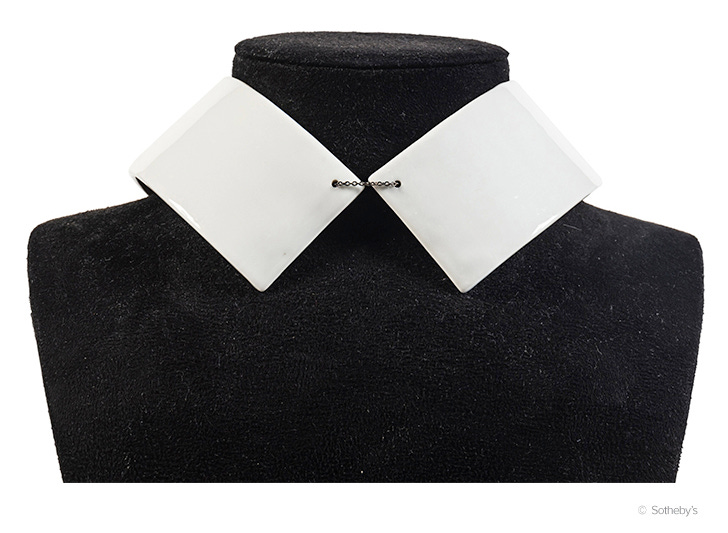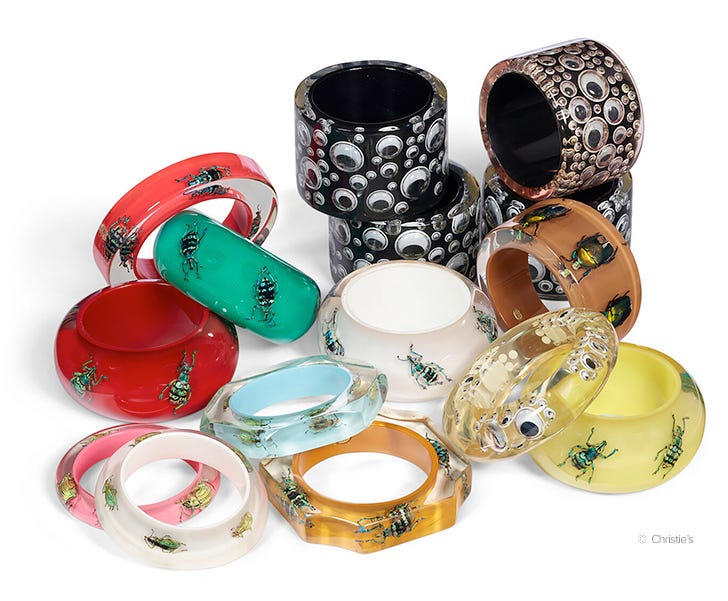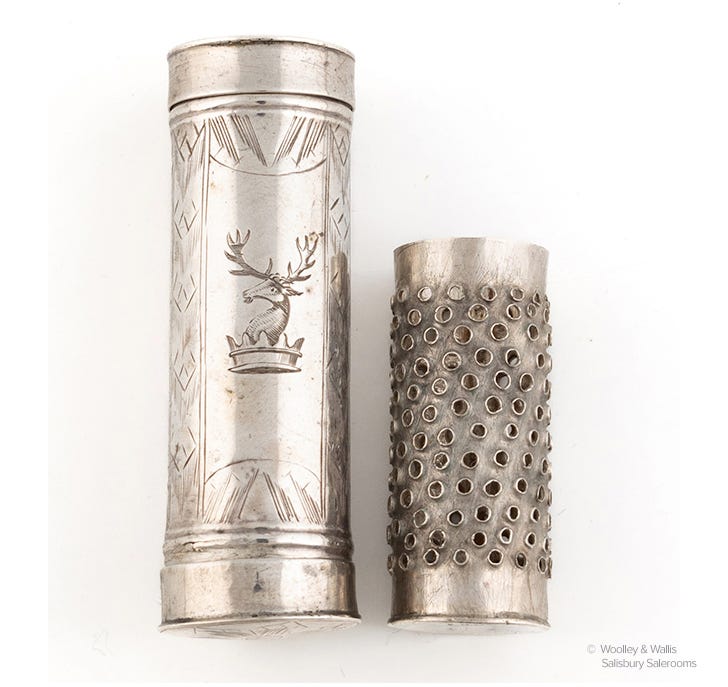The iciest of bowls, some googly-eye bangles and a nutmeg grater
And a collar made of porcelain
Hi all, sorry it’s been a while. I haven’t seen anything that’s really inspired me lately, to be honest. I’ve noticed that even in just the past 5-10 years there are far fewer interesting things coming up for auction. Sometimes it feels like it’s just a vast sea of VC&A Alhambra jewelry. But whatever; I guess even that’s a much-needed distraction these days?
In other news, last week Prince’s shirt from Purple Rain didn’t sell at Bonham’s, while Shaun’s bloody outfit from Shaun of the Dead did. (Granted, it was a lot cheaper). Anyway, on we go!
The final Karl Lagerfeld auction (in a seemingly never-ending series) is under way at Sotheby’s Paris and will continue until January 31. I don’t want to say it’s the leftover dregs, but there sure are a shit ton of iPods on offer in Karl Lagerfeld’s Estate V, Le Studio. And a single random spoon? There’s also one of Choupette’s cat beds, and it’s in black velvet of all things, darling. You know she haired that sucker up like a pro, but obviously that’s why she needed a coterie of personal maids.
Much of the sale contains clothing — including full outfits, or “total looks” — as well as fashion sketches and accessories. My eye was particularly taken by this white-enameled porcelain collar by the Berlin-based jewelry brand uncommon matters; I believe it was part of their debut collection. It’s a wee bit puritan, but I think that’s why I like it.
Note: Jessica of the Drinks with Broads and Go Fug Yourself team covered this auction in a recent newsletter and I was amused to read that I am not the only person to have once dressed up as Karl Lagerfeld for Halloween. Unlike Heather, though, I DID know he was a colossal asshole; I just wanted an excuse to buy a pair of driving gloves.
This wonderful silver ice bowl sold last week in the Christie’s New York Important Americana auction, and I couldn’t let it go by without a mention. It’s by Gorham and takes the form of a craggy, icicle-laced iceberg, with two polar bears patrolling the rim. The matching pierced spoon features a third menacing polar bear and a rope twisted around the handle.
The markings on the underside of the bowl tell us it is Gorham ice bowl #125, which debuted on April 15, 1870. It was the most popular ice bowl in the company’s inventory, and according to the lot notes, the bowl’s design was inspired by current events:
The iconography of the present ice bowl relates to the 1867 purchase of Alaska from Russia for $7.2 million, or about two cents per acre, by Secretary of State William H. Seward under President Andrew Johnson. Originally ridiculed by Congress and the press, the new Territory of Alaska was dubbed as Seward’s “ice box” and President Johnson’s “polar bear garden.” Also at this time, the Bostonian Frederic Tudor (1783-1864) developed the technology to harvest, market, and sell ice to an affluent client base. Therefore, as a luxury good in the late 19th century, silver ice bowls such as this one, decorated with motifs of icebergs and polar bears possibly referring to the contemporary nicknames for the Territory of Alaska, reflected its value and prestige.
It was estimated at $20,000 – $30,000 and sold for just a hair more at $32,760.
In general, this is an fun auction to scroll through — there are loads of unnerving children, some seriously bananas furniture, and even a hand-written ca. 1788 copy of the Declaration of Independence that sold for $2,470,000.
This particular portrait also caught my eye, not just because of the uncanny resemblance to Esteemed Character Actress and Fugitive from the Law Margo Martindale. It’s actually thought to be a portrait of First Lady Martha Washington by William Beechey (1753-1839), but whoever it is, I love the understated warmth of her expression as her tiny, almost-hidden dog licks her ungloved hand.
A Swedish wedding crown! This one, in gilded silver with cultured pearl and rock crystal embellishments, dates to around 1962 and was made by the silversmith company Ceson of Gothenburg, Sweden. It’s included in the Weekly Jewelry sale ending today at Bonhams Los Angeles, and is estimated at $400-$600.
Swedish bridal crowns, or brudkrona, date back to the Middle Ages and originated as a Catholic tradition based around the veneration of the Virgin Mary (a.k.a. the Queen of Heaven). The crowns were usually owned by the local church and loaned out to the bride on her wedding day, and while they mainly symbolized chastity and virginity, some also included references to conjugal love, like this ornate early 18th century crown in the Walters Art Museum that features carnations and linden leaves, symbols of enduring marriage and fertility. According to the Swedish-American newspaper Nordstjernan, the crown tradition began to wane early in the 20th century, but is starting to reappear “with the more elaborate, large weddings of late.”
Fashion icon Iris Apfel passed away last year at the age of 102, and 200 items from her personal collection will be offered for sale in Unapologetically Iris: The Collection of Iris Apfel, a Christie’s New York online auction beginning today.
Never without her trademark gigantic round eyeglasses, Apfel’s maximalist personal style was influenced by her travels all over the world for the Manhattan textile firm she had established with her husband in 1950. The pair specialized in reproducing textiles from previous centuries, and their restoration work drew very high-end clients, including no less than NINE U.S. presidents.
Iris was renowned in the fashion and interior design world for mixing and matching colors, textures and patterns in bold, flamboyant ways that, in her hands, seemed effortless and perfect. Her talent didn’t fully break through to the public until 2005, though, when the Costume Institute at the Metropolitan Museum of Art featured an exhibition of her wardrobe Rara Avis: Selections from the Iris Barrel Apfel Collection. It was the first time the Institute honored a living person who wasn’t an actual fashion designer.
Iris didn’t slow down even in her nineties — she was the focus of a documentary in 2014, was immortalized as a Barbie doll in 2018, and in 2019, at the age of 97, she signed a modeling contract with IMG (she liked to call herself a “geriatric starlet.”) Sadly, she lost her husband Carl in 2015, but the two had been happily married for 67 years, and Carl lived to the age of 100.
The collection at Christie’s is a marvel of color, feathers, beads and bangles, and of course I have to shoutout the bangles here, since she was never without an armful. The lot above features two groupings of multicolored lucite bangles, five (including four cuffs) with a googly-eye motif, and the other ten adorned with colorful little beetles. They’re estimated at $300 - $500 but there’s no way they’re going for that low.
I also have to point out “Gussy,” a life-size wooden ostrich that was one of six Iris commissioned in the 1970s. Gussy has a secret surprise, however. Christie’s quotes an interview she did with InStyle Magazine in 2018:
“I used to have my own interior-design business, and every year I’d do a few big buying trips. In the ‘70s I went to Italy and visited the workshop of a fabulous wood carver. I knew I wanted him to make me something, and since I love ostriches, I came up with the crazy idea of having a life-size one carved out of this beautiful bleached wood. Then I thought, ‘Wouldn’t it be wonderful if it was a bar too?’ So I designed the wing on a hinge, which allows you to open the ostrich and fill the belly with booze.”
Speaking of ostriches (that’s not something I often get to say), if you have a spare $500,000 – $800,000, why don’t you treat yourself to a 17th century gilded ostrich cup? This German parcel-gilt (which means it’s all silver and some of it is gilded) cup and cover takes the form of an ostrich with a bejeweled and enameled collar. It features the mark of Andreas I Wickert, Augsberg, 1651-1654, and a later coat-of-arms for Johann Joseph Koffler, Edler von Kofflern (1708-1767).
The head and neck of the ostrich are detachable, and the horseshoe in its mouth is a reference to a myth that the bird could digest anything, including iron and other metals. Shakespeare also pitched in:
In Henry VI, Part II, Shakespeare writes a colorful threat for the rebel Jack Cade as he draws his sword on his enemy, Alexander Iden: ‘Ah villain… I’ll make thee eat iron like an ostrich, and swallow a sword like a great pin, ere thou and I part’ (act IV, scene 10).
Even though the myth was debunked, the ostrich still wound up becoming a symbol of the iron industry — a symbol that would appeal to Koffler, who, as Master of the Mint and Mining for the Austrian province of Steiermark, was instrumental in modernizing the iron mining industry in that area.
The piece is included in the Christie’s New York Global Treasury: The Life and Collection of Selim & Mary Zilkha live auction on February 6th.
I think I’ve found a new quest. The Silver & Objects of Vertu sale at Wooley & Wallis on February 5 features a collection of over 30 antique silver nutmeg graters and I’m thoroughly charmed. Much like vesta cases, nutmeg graters were made in many different shapes and sizes — tiny eggs, boxes, cylinders, barrels, etc. — and if you would like to scroll through the collection, the graters start at lot 697.
Nutmeg has a long and bloody history, as Europeans battled and enslaved island villages in Indonesia for control of production, and the Dutch actually traded Manhattan to the British in 1677 in return for a claim on one of those islands. Use of the spice goes back centuries, and it was thought to have medicinal benefits — one account from 1597 claimed it was “good against freckles in the face” — as well as mystical or magical properties, since it’s a potent hallucinogen when consumed in large quantities.
Nutmeg graters first became popular among the wealthy (the only people who could afford it) in the early 1600s, and according to Kovel’s Antique Trader:
Pocket graters for gentlemen to include in their traveling tableware sets emerged in the mid-1600s. The first ones were just cylindrical silver graters, with a solid silver tube acting as a case to store them in. Later, elaborately decorative ones emerged made from silver, gold, ivory, brass, and enamel.
The late-17th century cylindrical grater above has a maker’s mark that indicates it was probably made by Thomas Kedder in London sometime around 1690-1700. The initials “S.F.” are scratched into the surface along with a later engraved crest, and the grater can be pulled out of the interior. It’s estimated to sell for between £400 - £600, or $498 - $747.
I’m also charmed by the unmarked but beautifully inscribed oval grater in this lot, which was a precious gift “From Louisa to Clara.”
I didn’t know pastry forks existed, but of course they do. And these are beautiful. Made by Archibald Knox (1864-1933) in his “Medea” pattern for London’s Liberty & Co., they date to around 1902, with a design that features three elongated seed pods surrounded by blue-green enamel.
Knox’s work spans the Arts & Crafts, Celtic Revival and Art Nouveau styles, and as a lead designer for Liberty, his designs were widely known and influential. He also was a teacher, and this account from one of his former students makes it sound like he may have been the first person to use slides to teach art history. (I would explain what “slides” are to my younger readers, but that may result in me shattering into a pile of Gen X dust.)
The forks are included in the Modern Design online auction ending February 6 at Skinner Marlborough, and they’re estimated to sell for $400 - $600.
I humbly implore you to further indulge this former art history major: You can actually buy a mothereffing El Greco. An EL GRECO! And St. Sebastian, no less! That exact painting was on the cover of one of my textbooks in college. Good god. Unfortunately it’s estimated at $7,000,000 – $9,000,000 USD, so it’s not like a normal human being can buy it and our billionaires are all gaping cultural voids and/or Nazi shitbags, so *sad trombone.*
Well, that’s it for now. Just a quick reminder that Saturday is Imbolc, the halfway point between the winter solstice and the spring equinox. Get your corn dollies ready and don’t forget to make a bed for St. Brigid so your crops won’t fail.
Bye, M x











Excuse me, that's not by Gorham it's by Gotham and it is owned by Mr. Freeze
I'd have to sell my 18th Century Claremont Persian Rug, but an El Greco would totally rock my dining room wall.
Next to my Scooby-Doo Nutmeg Grater/Pez Dispenser.